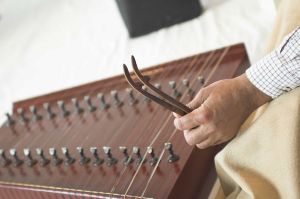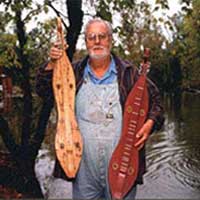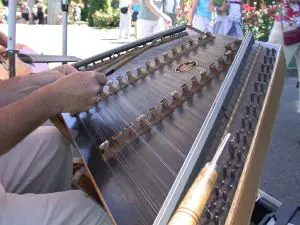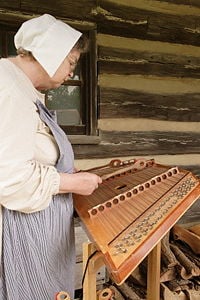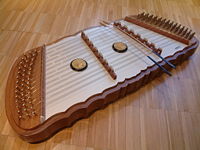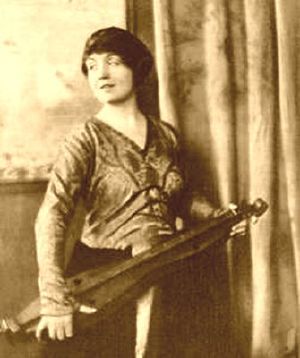Dulcimer
The dulcimer is a stringed musical instrument of two main varieties. In the case of the hammered dulcimer, the strings are stretched over a trapezoidal sounding board. Typically, the hammered dulcimer is set on a stand at an angle in front of the musician, who holds small mallet hammers in each hand to strike the strings. The Appalachian dulcimer, also called a mountain dulcimer, is a narrower instrument of the zither family with three to five strings and a fretted fingerboard. It is held on the lap and played by strumming with a small stick, quill, or plectrum with the right hand, while the left hand controls the melody or chords.
The word dulcimer is Graeco-Roman, meaning "sweet song," derived from the Latin dulcis (sweet) and the Greek melos (song). The dulcimer's origin is uncertain, but tradition holds it was invented in Iran some 2000 years ago, where it is called a Santur (cf. the folkloric Kashmiri Santoor). There are wood carvings that depict stringed instruments played with wooden beaters dating as far back as 1500 B.C.E. The origins of the Appalachian dulcimer are uncertain, but they may have evolved from diatonic fretted zithers found in continental Europe.
Both hammered and Appalachian dulcimers have been revived in the U.S. in the American folk music traditions. Some rock bands employ the hammered dulcimer as a primary instrument, including Macha of Athens, GA, and Tulsa Drone of Richmond, VA. The hammered dulcimer is played in Wales, East Anglia, Northumbria, Southwest Asia, China, and Thailand, and in traditional Austrian and Bavarian folk music.
Hammered dulcimer
The early version of the dulcimer (santur) was known in cultures from Greece to Mongolia and was known in India and throughout the Middle East and was widely used in rural areas due to its portability and relative ease of use. It was often used to accompany weddings and dances. It later became an instrument that was associated with folk music and buskers.
One reason for its eventual decline was that is was not easy to build quality instruments that could stay in tune. The instrument did not achieve the popularity that the harpsichord or piano did, and because European composers of the seventeenth, eighteenth, and nineteenth centuries did not write music for it.
Strings and tuning
The hammered dulcimer comes in various sizes, and is also identified by the number of strings that cross each of the bridges. A 15/14, for example, has two bridges (treble and bass) and spans three octaves. The strings of a hammered dulcimer are usually found in pairs, two strings for each note (though some instruments have three or four strings per note). Each set of strings is tuned in unison and is called a course. As with a piano, the purpose of using multiple strings per course is to make the instrument louder, although as the courses are rarely in perfect unison, a chorus effect usually results. A hammered dulcimer, like an autoharp or harp, requires a tuning wrench for tuning. Unlike the strings of a guitar, the dulcimer's strings are wound around simple bolts (called tuning pins) with square heads.
The strings of the hammered dulcimer are often tuned diatonically, according to a circle of fifths pattern. Typically, the lowest note (often a G or D) is found on the lower right-hand corner of the instrument, just to the left of the right-hand (bass) bridge. As a player strikes the courses above in sequence, they ascend the diatonic scale based on the G or D. With this tuning, the scale is broken into two tetrachords, or groups of four notes. For example, on an instrument with D as the lowest note, the D major scale is played starting in the lower-right corner and ascending the bass bridge: D - E - F# - G. This is the lower tetrachord of the D major scale. At this point the player returns to the bottom of the instrument and shifts to the treble bridge to play the higher tetrachord: A - B - C# - D.
This shift to the adjacent bridge is required because the bass bridge's fourth string G is the start of the lower tetrachord of the G scale. If the player ascends the first eight strings of the bass bridge, they will encounter a flatted seventh (C natural in this case), because this note is drawn from the G tetrachord. This D major scale with a flatted seventh is the mixolydian mode in D.
The pattern continues to the top of the instrument and to the left-hand side of the treble bridge. Moving from the left side of the bass bridge to the right side of the treble bridge is analogous to moving from the right side of the treble bridge to the left side of the treble bridge.
This diatonically-based tuning results in most, but not all, notes of the chromatic scale being available in each key. To fill in the gaps, many modern dulcimer builders include extra short bridges at the top and bottom of the soundboard, where extra strings are tuned to some or all of the missing pitches. Such instruments are often called "chromatic dulcimers" as opposed to the more traditional "diatonic dulcimers."
Hammered dulcimers of non-European descent may have other tuning patterns, and builders of European-style dulcimers sometimes experiment with alternate tuning patterns.
Hammers
The hammered dulcimer derives its name from the small mallets that players use to strike the strings, called hammers. They are usually made of wood, but can be made from any material, including metal and plastic. In the Western hemisphere, hammers are usually stiff, but in Asia, flexible hammers are often used. The head of the hammer can be left bare for a sharp attack sound, or can be covered with adhesive tape, leather, or fabric for a softer sound.
The hammered dulcimer (as well as the mountain dulcimer), can also be bowed, though this is not a widespread practice, as a traditional bow would do little good. The "four hammer dulcimer" premiered in the 1990s and is the same instrument played with special hammers and technique.
Hammered dulcimers around the world
Versions of the hammered dulcimer are used throughout the world. In Eastern Europe a larger descendant of the hammered dulcimer called the cimbalom is played and has been used by a number of classical composers, including Zolt√°n Kod√°ly, Igor Stravinsky, and Pierre Boulez, and more recently, in a different musical context, by Blue Man Group. The khim is a Thai hammered dulcimer. The Chinese yangqin is a type of hammered dulcimer that originated in Persia. The Santur and Santoor are found in the Middle East and India, respectively.
The cimbalom, which is similar to the hammer dulcimer, has been used by serious composers in the twentieth century. Hungarian composer Zoltán Kodáky featured the cimbalom extensively in his orchestral suite Háry János which helped popularize the instrument outside Europe. Bartok scored for cimbalom in his Rhapsody #1 for Violin and Orchestra. Russian composer Igor Stravinsky owned a cimbalom and included the instrument in two of his compositions Renard and Les Noces. Contemporary composers who utilized the cimbalom in their works include Pierre Boulez, Peter Eötvös, György Kurtág, Frank Zappa, Louis Andriessen Henri Dutilleux, Elvis Costello, and Harrison Birtwhistle.
Appalachian dulcimer
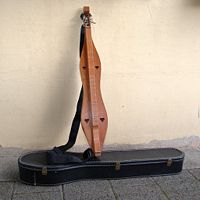
| ||||||
|
The Appalachian dulcimer is a fretted string instrument of the zither family, typically with three or four strings. The body extends the length of the fingerboard, and its fretting is generally diatonic.
Although the Appalachian dulcimer appeared in regions dominated by Irish and Scottish settlement, the instrument has no known precedent in Ireland or Scotland. However, several diatonic fretted zithers exist in continental Europe which bear a strong similarity to the dulcimer. Appalachian folk music expert and dulcimer player Jean Ritchie and others have speculated that the Appalachian dulcimer is related to similar European instruments like the langeleik, scheitholt, and epinette des Vosges.
Playing
A traditional way to play the instrument is to lay it flat on the lap and pluck or strum the strings with one hand, while fretting with the other. The dulcimer may also be placed in a similar position on a piece of furniture such as a table or chest of drawers, which may enhance the sound.
There are two predominant methods of fretting. First, the strings may be depressed with the fingertips of the fretting hand. Using this technique, all the strings may be fretted allowing the player to produce chords. Second, the melody string, the string closest to the player, may be depressed with a noter, typically a short length of dowel or bamboo. Using this method, only the melody string is fretted and the other strings act as drone strings.
In practice, a wide variety of playing styles have long been used. For example, it may be played with a bow instead of a pick, with the tail of the dulcimer held in the player's lap, and the headstock resting on a table. It can also be played "guitar style:" The dulcimer either hangs from a strap around the neck or his held up sideways on the lap, and the instrument is fretted and strummed like a guitar. Still other dulcimer players use a finger style technique, fingering chord positions with the fretting hand and rhythmically plucking individual strings with the strumming hand, creating delicate arpeggios.
Contemporary players have also borrowed from chord theory and guitar analogues to create a variety of more complex ways to play the dulcimer. Some dulcimers are constructed with four equidistant strings to facilitate playing more complex chords, particularly for playing jazz. In another line of contemporary innovation, electric dulcimers have been used in rock music. The Appalachian dulcimer is both easy to learn to play, and capable of complexity, providing scope for a wide range of professionals and hobbyists.
Strings and tuning
The frets of the Appalachian dulcimer are typically arranged in a diatonic scale. Traditionally, the Appalachian dulcimer was usually tuned to DAA, or notes with this 1-5-5 relationship. The key note is on the bass string and the middle string is an interval of a perfect fifth above it. The melody string is tuned so that the key note is at the third fret. This facilitates playing melodies in the Ionian mode. The melody played on the top string (or string pair) only, with the unfretted drone strings providing a simple harmony, gives the instrument its distinctive traditional sound. To play in a different key, or in a different mode, a traditional player would have to retune the instrument. For example, to play a minor mode melody the instrument might be tuned to DAC. This facilitates playing the Aeolian mode, where the scale begins at the first fret.
Modern instruments usually include an additional fret a half step below the octave position, the so-called "six and a half" fret. This enables one to play in the Ionian mode when tuned to DAD, the traditional tuning for the Mixolydian mode, where the scale starts on the open fret. This arrangement is often found to be more conducive to chordal playing, as opposed to the more traditional dronal style. Among modern players, the instrument is most commonly tuned to DAD. So-called "chromatic dulcimers" are sometimes made to permit play in any key without re-tuning.
Usage
The Appalachian dulcimer is widely used in the American old time music tradition. The instrument first appeared in the early 1800s from the Scots-Irish in the southern Appalachian Mountains, and is thus also called a mountain dulcimer. The instrument became used as a parlor instrument, as its sound volume was well-suited to small home gatherings.
The Appalachian dulcimer achieved a renaissance in the 1950s urban folk music revival in the United States through the work of Jean Ritchie, a Kentucky musician who introduced the instrument to New York City audiences. In the 1960s, the American folk musician Richard Fari√Īa (1937‚Äď1966) became the first to utilize an Appalachian dulcimer in a less traditional way, pointing out its similarity in tone to some Middle Eastern and Asian instruments. Styles performed by modern dulcimer enthusiasts run the gamut from traditional folk music through popular and experimental forms, although most perform in more or less traditional styles. More recently, solid-body electric mountain dulcimers have also appeared. Dulcimer festivals take place regularly in the United States, Canada, the United Kingdom, and Ireland, as the Appalachian dulcimer has achieved a following in a number of countries.
Variants
As a folk instrument, wide variation exists in Appalachian dulcimers.
- Number of Strings: Dulcimers may have as few as two or as many as 12 strings (in six courses). Instruments with fewer than two strings would more properly be termed monochords.
- Body Shape: Dulcimers appear in a wide variety of body types, including hourglass, teardrop, trapezoid, rectangular, elliptical, violin-shaped, fish-shaped, and lute-back.
- Courting Dulcimer: One unusual variant is the "courting dulcimer." This instrument consists of one large dulcimer body with two separate fingerboards. The instrument is laid across the laps of two facing individuals (the eponymous "courting" pair) and used to play duets.
- Bowed Dulcimer: Dulcimers that have been specially modified to be played with bows.
Other innovations include the banjo dulcimer, also called a banjo-mer, resembling a standard dulcimer, but with a banjo head on the body. A Resonator dulcimer is a standard dulcimer with a resonator added to the body, in imitation of the resonator guitar.
ReferencesISBN links support NWE through referral fees
- Gifford, Paul M. The Hammered Dulcimer: A History. Lanham, MD: Scarecrow Press, 2001. ISBN 0810839431.
- Ritchie, Jean. Jean Ritchie's Dulcimer People. New York: Oak Publications, 1975. ISBN 9780825601422.
- Smith, Ralph Lee. Appalachian Dulcimer Traditions. Lanham, MD: Scarecrow, 2002. ISBN 9780810841352.
Credits
New World Encyclopedia writers and editors rewrote and completed the Wikipedia article in accordance with New World Encyclopedia standards. This article abides by terms of the Creative Commons CC-by-sa 3.0 License (CC-by-sa), which may be used and disseminated with proper attribution. Credit is due under the terms of this license that can reference both the New World Encyclopedia contributors and the selfless volunteer contributors of the Wikimedia Foundation. To cite this article click here for a list of acceptable citing formats.The history of earlier contributions by wikipedians is accessible to researchers here:
The history of this article since it was imported to New World Encyclopedia:
Note: Some restrictions may apply to use of individual images which are separately licensed.
